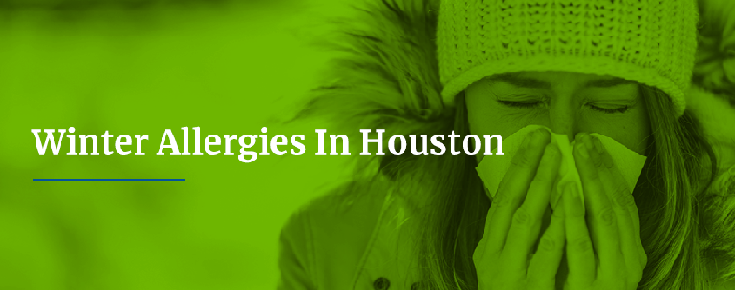
In Houston, winter weather may seem like a breeze for those looking to escape frigid temperatures and avoid snow. Due to Texas’ warmer climate, winters tend to be mild. However, this climate also causes pollen in Houston and the surrounding areas to stick around, negatively impacting allergy sufferers in the Lone Star State. The prevalence of allergic diseases has been on the rise for more than 50 years, affecting as many as 50 million people across the U.S. Warmer winters tend to result in an early start to allergy season, so it may be challenging to find relief from winter allergies.
Why Do Allergies Occur in Winter?
Since allergies are a chronic disease, people who suffer from allergies likely experience them for prolonged periods or very frequently. Allergies are also one of the most common chronic illnesses, affecting up to 30% of U.S. adults and 40% of U.S. children. In Houston, allergy season drags into late fall before pollen counts start rising again as soon as January, creating a continuous cycle. However, winter outdoor allergies aren’t solely to blame. In addition to an early-starting allergy season, you may also be experiencing severe allergies in winter from spending an increased amount of time indoors during the season.
Being Indoors vs. Outdoors
Even if the weather doesn’t drop to freezing temperatures in Houston, people are still likely spending more time indoors during the winter months, especially during the holiday season. Although indoor allergens affect millions of people during the entire year, prolonged exposure to these allergens is highest in winter, since people are inside more. So even though you might catch a break from pollen and other outside elements by staying in, you’re susceptible to more winter indoor allergies. Some indoor winter allergy causes include coming in contact with things like dust, mold and pets.
Exposure to Dust
Dust is a prevalent indoor allergen found in homes across the U.S. all year. Dust mites are tiny organisms invisible to the naked eye. They feed off dust in places like pillows, carpeting, mattresses and other upholstered furniture. Dust mites prefer warm, humid habitats, reliant on the moisture in the air. If you typically host guests during the winter months and do a lot of cleaning beforehand, you could be stirring up dust and triggering winter allergy symptoms after you vacuum, dust or sweep.
To minimize exposure to dust mites, consider these tips:
- Get rid of items in your home known to cause dust.
- Make sure your vacuum has a HEPA filter.
- Purchase mite-proof mattress cases and pillowcases.
- Frequently wash linens in hot water.
Exposure to Mold
Mold can easily find a damp place to grow inside your home and set off your allergy symptoms. Molds are everywhere, and upsetting a mold source can send spores, or seeds, into the air and cause an allergic reaction when inhaled, such as a sore throat or nasal congestion. The kitchen, bathroom and basement are all hot spots inside your home where mold may be hiding — many times, you can’t spot mold unaided. Therefore, prevention is the best way to prevent mold from triggering seasonal allergies as you spend more time inside during the winter.
Here are a few ways to prevent mold from growing in your home to keep your allergic reactions at bay:
- Keep indoor humidity low — at least below 45% — since mold survives in humid areas.
- Clean up any spills immediately.
- Repair any leaks.
- Clean fridge doors and garbage cans.
- Use fans and dehumidifiers.
- Remove any other source of dampness.
Exposure to Pets

Spending more time inside also increases your exposure to pets and the allergens they may cause. If you experience allergy symptoms from pets, you’re not alone — up to three in 10 people have allergic reactions to dogs and cats in the U.S., with cat allergies roughly twice as common as dog allergies. Pets have harmless proteins in their saliva, dander or urine that may cause an allergic reaction. Pet hair itself is not an allergen, but it may collect saliva, dander or urine and cause an allergic reaction, and may even carry other allergens like dust or pollen and bring them inside. Pet hair tends to collect just about everywhere — furniture, clothing, walls and other surfaces — and is challenging to get rid of.
To make sure you and your pet can keep living in harmony, consider these tips to minimize allergic reactions:
- Keep your pet out of your bedroom.
- Steam-clean carpets.
- Wash rugs in hot water.
- Change your clothes if they have animal hair on them.
- Bathe your pet regularly.
- Wash your hands thoroughly after playing with your pet.
Symptoms of Winter Allergies

To identify winter allergy causes, you need to know what you’re looking for. While allergies and colds tend to have a lot of the same symptoms, it can be challenging to tell the two apart. Colds will sometimes cause a fever, whereas allergies will never produce a fever. However, the most significant distinguishing factor between a cold and allergies is how long symptoms persist. If you notice that you always tend to get a cold around winter that lasts for a long time, it’s likely allergies. Symptoms of seasonal allergies tend to stick around for six weeks at a time, but increased indoor exposure to allergens in winter can prolong them. You must identify these symptoms first and foremost, so you can work toward fighting off your winter allergies. Here are some winter allergies symptoms you’re likely experiencing.
Headache
Many adults are no stranger to headaches — 50% of the North American population gets at least one headache a month, while 15% experience them weekly. Since headaches are such a common occurrence, it may surprise some that they are also a primary symptom of allergies. Two main types of headaches link specifically to allergies: sinus headaches and migraines.
Sinus headaches tend to cause pain around the sinus area and in the face. Built-up pressure from swollen sinuses blocks openings and prevents any drainage. Pollen, mold or pet dander can cause sinus headaches. There is also a link between migraines and environmental allergies. These headaches cause more severe pain, usually on one side of the head, and worsen when exposed to light. People suffering from migraines may also experience nausea.
Cough
While some strong coughs may die down after a week or even a few days, a persistent dry cough that has gone on for more than three weeks could indicate winter allergies. If you have a cough for more than six weeks, you could even suffer from chronic cough syndrome. If you notice you cough more in specific environments, you may be able to pinpoint the allergens contributing to your cough, like dust, pet dander, mold or pollen. Chronic cough also links with post-nasal drip and allergic rhinitis, or hay fever, and often occurs when your airways are swollen or irritated. While flu or cold coughs result from your immune system’s reaction to an infection, allergy-related coughs are your immune system’s reaction to allergens. Once you recognize your cough is a sign of allergies, you can work to eliminate allergens.
Fatigue
Everyone has days where they feel extra tired and nights where they toss and turn, but if you think a good night’s sleep seems impossible, you may be suffering from allergies. Studies have found people with allergies are much more likely to have poor sleep, and when you combine this with other allergy symptoms such as coughing or a stuffy nose, you have a recipe for fatigue. Harvard Medical School also found a link between fatigue and allergies — many people who have chronic fatigue syndrome also have allergies. Your body can release chemicals in response to an allergic reaction that causes fatigue. Additionally, many over-the-counter medications to help with allergy symptoms affect sleep. They may also result in fatigue, so find a medication that helps with your symptoms without causing any more.
Itchy Eyes and Skin
Itchy, irritated eyes and skin are additional symptoms contributing to winter skin and eye allergies. If your eyes are red, itch and water a lot, it is a sign of allergies, specifically allergic conjunctivitis. Eye allergies affect millions of Americans, but are easy to overlook. While outdoor allergens like pollen may cause these allergies, spending more time indoors in the winter months can also have a significant impact, as pet dander, dust mites and mold contribute to eye allergies. These allergens meet up with antibodies on the mast cells in your eyes, and these cells then release histamine and other chemicals that affect the tiny blood vessels in the eye and cause them to leak. This cascade of responses then causes itchy, red and irritated eyes that may even burn. While some cases are very mild, allergies affecting the eyes can be severe enough to impact vision.
Eczema, or atopic dermatitis, may also be a symptom of winter allergies, often linked to allergic rhinitis. Additionally, inhalant allergens — specifically dust mites — also have an association with eczema. Often, dust mites or other allergens and eczema occur together. Eczema causes very itchy, dry skin that appears chafed and red when scratched.
Other Symptoms
In addition to headaches, cough, fatigue and itchy eyes and skin, when suffering from winter allergies, you may also experience symptoms such as:
- Sore throat
- Stuffy nose
- Runny nose
- Sneezing
- Wheezing
How to Alleviate Winter Allergies
Just because you have allergies doesn’t mean you have to feel miserable all winter long. While it can feel like forever before you get some relief from your persistent allergy symptoms, there are ways you can make them more manageable. Consider things such as running a humidifier, using natural scents and cleaning your house to start alleviating your winter allergies so you can escape the winter blues and get back to feeling great.
Run a Humidifier
While you’re suffering from winter allergies, your sinus passages can become dry and irritated. Consider running a humidifier to treat your nasal passages so you can be as comfortable as possible. However, since many people suffer from indoor allergens during winter, you must be cautious using a humidifier, since allergens like dust mites and mold thrive in humid air. Use a hygrometer to keep track of humidity levels in your home, especially if you’re using a humidifier, and ensure it never exceeds 50%. To prevent mold, you should regularly change your humidifier’s filter and clean your humidifier. Try only to use water without minerals, since high mineral levels can encourage bacterial growth.
Use Natural Scents
Aromatherapy can help alleviate symptoms of winter allergies so you can get some relief. You can use essential oils by inhaling them, which distributes the molecules into the respiratory system, or apply them directly on the skin, in places like the chest or directly under the nose. When you use essential oils this way, the epidermis absorbs them and the soft tissue transfers them to the bloodstream, then to the treatment areas before being metabolized in the liver. It’s a best practice to dilute the oils for topical use by mixing them with another oil, such as olive oil, lotion or aloe jelly. If you plan to inhale the oils, use a waterless diffuser to keep any waterborne bacteria away.
Oils like peppermint and eucalyptus contain menthol, so they are ideal for helping unclog stuffy sinuses. However, for those who have high blood pressure or other heart problems, only use eucalyptus since peppermint is a stimulant. If you’re suffering from a bad chest cough, consider using frankincense oil to keep it under control. Frankincense makes an effective immune stimulant or decongestant as well.
Clean
Even if your allergy symptoms improve, allergens like pesky dust mites can pose a threat the longer they remain in your home. Continue on the path to progress when it comes to alleviating allergy symptoms by cleaning your home regularly. If it’s been some time since you last cleaned, consider a deep clean first and then follow with regular cleanings. Since cleaning can sometimes stir up allergens in the home, always remember to wear a mask to avoid breathing them in.
Here are some cleaning steps you should take to start eliminating allergens:
- Dust often.
- Vacuum at least once a week.
- Keep clutter to a minimum.
- Get rid of any items that may collect dust or mold.
- Store any items you wish to keep in plastic boxes or cloth bags.
- Wash sheets and pillows in hot water every week.
- Wash comforters, blankets and mattress pads every month.
- Make sure your kitchen countertops and underneath your sink are dry.
- Repair any leaks.
- Use a cleaner made specifically to eliminate mildew.
- Wash shower curtains regularly using bleach and detergent.
- Use exhaust fans to keep air moving.
- Shake out any entryway floor rugs outside before washing.
- Wash floor rugs weekly.
- Keep an eye out for any mold or mildew on window frames and wash them regularly.
Treatment for Winter Allergies

Although some people like to say allergies go away come winter, we know this and other winter allergy myths are not true — allergies can still run their course during the winter months. Start acknowledging your symptoms for what they are so you can seek treatment and get some relief. With plenty of available allergy treatment options, you can find one that will target your specific needs and the severity of your symptoms. Whether you suspect you have allergies and need testing to confirm it, or you want to try something new, take back control and seek allergy treatment as soon as possible.
Allergy Testing
Are you experiencing allergy symptoms or suffering from allergic reactions, but don’t know what causes them? Get tested for allergies. There are three different types of skin tests as well as radioallergosorbent testing, or RAST, so you can pinpoint what allergens are giving you trouble once and for all.
The three types of skin tests include the skin prick test, the intradermal test and the skin patch test. For the skin prick test, the doctor puts a drop of the potential allergen on the skin and performs small needle pricks or scratches so the solution can enter the skin. If you test positive, you will develop red, itchy bumps on your skin.
For intradermal tests, the doctor injects a small amount of the potential allergen into the skin. Health professionals usually do this test if you don’t react to a suspected allergen during the skin prick test, since it is a more sensitive option. However, one downside to the intradermal tests is that they sometimes give false positive results for people who show no symptoms of an injected allergen.
Lastly, skin patch tests can help look for contact dermatitis, a skin allergy. During this test, doctors put the allergen on a pad and tape it to your skin for 24 to 72 hours. Skin testing is a relatively quick process, as reactions typically appear within 20 minutes and go away within hours.
RAST is a type of specific immunoglobulin blood testing. RAST looks at any antibodies in your blood that could potentially cause allergies. The blood sample gets tested in a lab to see how it reacts to possible allergens. It’s possible to test many different allergens, including indoor allergens responsible for your winter allergies, with the single blood sample.
Immunology
Immunology is ideal for those suffering from allergies caused by indoor irritants and for those who suffer from seasonal allergens, such as pollen. There are two main options when it comes to immunology — allergy shots and sublingual immunotherapy.
Allergy shots are an effective solution for those who:
- Can’t avoid allergens that trigger allergic reactions
- Don’t find medicine helpful for their allergy symptoms
- Get adverse effects from medication or are on other medication that doesn’t interact well with allergy medicine
- Want to cut back on using allergy medication altogether
So how do allergy shots work? These shots contain a tiny amount of the allergens known to cause a reaction in the person receiving the shots — just enough to put your immune system in drive without causing an entire reaction. As patients receive more and more shots, doctors gradually up the allergen dose in each shot, so the body builds up immunity during the process.
However, shots may not be the best option for everyone. According to the Chapman University Survey of American Fears from 2018, 12.9% of adults said they were afraid of needles. Luckily, sublingual immunotherapy, SLIT, is a popular alternative to allergy shots that many find more tolerable. This method works similarly, but instead of the shot, patients receive drops under the tongue. Allergy sufferers can find relief in taking sublingual immunotherapy in liquid form or as tablets. It works not only to treat symptoms, but to address what’s causing the allergen.
Even if you aren’t scared of needles, SLIT may prove to be a more convenient option. You can take these drops at home, whereas you would have to visit the doctor’s office every week with allergy shots. There also tend to be fewer side effects with this method, as side effects with the drops might include a mildly itchy or swollen mouth and some throat irritation, which usually disappear within 24 hours. Plus, research has found SLIT is just as effective as allergy shots.
Turbinate Reduction
Are you sick continuously spending your money on over-the-counter allergy medication, only to still have trouble breathing through your nose? Turbinate reduction could be the answer you’re searching for. Turbinates are structures inside your nose that help regulate moisture and temperature. When they swell and become enlarged or get displaced, it makes it harder for you to breathe. Most of the time, turbinate displacement or enlargement will eventually go away on its own, but it may not correct itself in cases where people suffer from severe allergies. Therefore, if you are seeking nasal relief from severe allergies, you may be an excellent candidate for turbinate reduction.
Turbinate reduction is a quick procedure, sometimes only taking five minutes. It works to make your turbinates smaller and eliminates nasal drip and that dreaded stuffy nose feeling so you can breathe with ease. You will also save money on tissues, allergy medication and nasal sprays.
Visit Houston Sinus and Allergy for Allergy Relief This Winter
Living in Houston may help keep frigid, winter weather at bay, but allergies tend to stick around. With allergy season starting early in Houston, combined with spending more time indoors during the winter, you’re sure to be exposed to allergens. While you can alleviate some of these symptoms with relatively simple practices, some allergy cases require treatment. If you’re ready to live comfortably again, book an assessment at Houston Sinus and Allergy with Dr. Nguyen to get the relief you’re seeking. Dr. Nguyen has been a leading ear, nose and throat expert and educator for more than 15 years, offering the expertise to treat and diagnose even the most challenging cases. Plus, Houston Sinus and Allergy is up to date with the newest advanced medical technology and accepts numerous insurance plans. Don’t wait — contact us today to get the allergy care you deserve.

